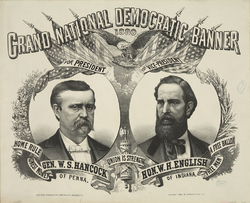
The 1876 United States presidential election was the 23rd quadrennial presidential election, held on Tuesday, November 7, 1876, in which Republican nominee Rutherford B. Hayes faced Democrat Samuel J. Tilden. It was one of the most contentious presidential elections in American history. Its resolution involved negotiations between the Republicans and Democrats, resulting in the Compromise of 1877, and on March 2, 1877, the counting of electoral votes by the House and Senate occurred, confirming Hayes as President. It was the second of five U.S. presidential elections in which the winner did not win a plurality of the national popular vote.
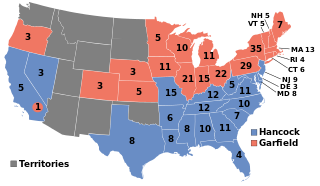
The 1880 United States presidential election was the 24th quadrennial presidential election, held on Tuesday, November 2, 1880, in which Republican nominee James A. Garfield defeated Winfield Scott Hancock of the Democratic Party. The voter turnout rate was one of the highest in the nation's history. Garfield was assassinated during his first year in office, and he was succeeded by his vice president, Chester A. Arthur.
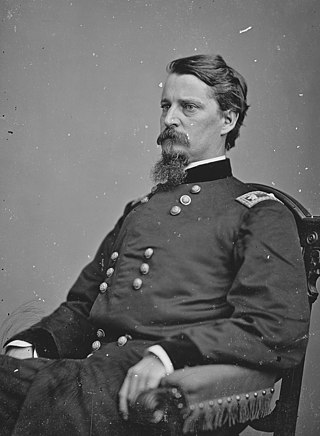
Winfield Scott Hancock was a United States Army officer and the Democratic nominee for President of the United States in 1880. He served with distinction in the Army for four decades, including service in the Mexican–American War and as a Union general in the American Civil War. Known to his Army colleagues as "Hancock the Superb," he was noted in particular for his personal leadership at the Battle of Gettysburg in 1863. His military service continued after the Civil War, as Hancock participated in the military Reconstruction of the South and the Army's presence at the Western frontier. From 1881 to 1885 he was president of the Aztec Club of 1847.

Samuel Jackson Randall was an American politician from Pennsylvania who represented the Queen Village, Society Hill, and Northern Liberties neighborhoods of Philadelphia from 1863 to 1890 and served as the 29th speaker of the United States House of Representatives from 1876 to 1881. He was a contender for the Democratic Party nomination for President of the United States in 1880 and 1884.
The 1880 Democratic National Convention was held June 22 to 24, 1880, at the Music Hall in Cincinnati, Ohio, and nominated Winfield S. Hancock of Pennsylvania for president and William H. English of Indiana for vice president in the United States presidential election of 1880.

The 1880 United States presidential election in California was held on November 2, 1880, as part of the 1880 United States presidential election. State voters chose six representatives, or electors, to the Electoral College, who voted for president and vice president.

The 1880 United States presidential election in New York took place on November 2, 1880. All contemporary 38 states were part of the 1880 United States presidential election. Voters chose 35 electors to the Electoral College, which selected the president and vice president.
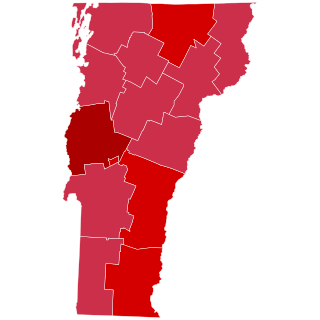
The 1880 United States presidential election in Vermont took place on November 2, 1880, as part of the 1880 United States presidential election. Voters chose five representatives, or electors to the Electoral College, who voted for president and vice president.

The 1880 United States presidential election in Rhode Island took place on November 2, 1880, as part of the 1880 United States presidential election. Voters chose four representatives, or electors to the Electoral College, who voted for president and vice president.
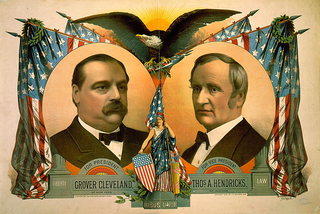
The 1884 presidential election was the first nationwide campaign in which Grover Cleveland participated and the first of two in which he emerged victorious. This election pitted Democratic Party nominee Cleveland against Republican party nominee James G. Blaine and the campaign centered on corruption, civil service reforms, and political scandals. In this election, Cleveland portrayed himself as the clean and honest candidate in contrast to Blaine, who was portrayed as corrupt.

The 1876 U.S. presidential election occurred at the twilight of Reconstruction and was between Republican Rutherford B. Hayes and Democrat Samuel J. Tilden. After an extremely heated election dispute, a compromise was eventually reached where Hayes would become U.S. President in exchange for the end of Reconstruction and a withdrawal of U.S. federal troops from the South.

After U.S. President William McKinley was assassinated in 1901, Theodore Roosevelt became the new U.S. President. Roosevelt's first term was notable for his trust busting, his successful arbitration in and resolution of a 1902 strike of 150,000 Pennsylvania coal miners, his advocacy against lynching, his conservation efforts, and the Panama Canal Treaty. In 1904, Roosevelt easily defeated Bourbon Democrat Alton Parker and won a second term as U.S. President.
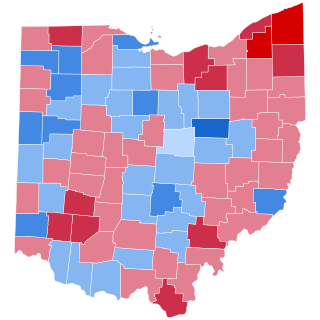
The 1880 United States presidential election in Ohio was held on November 2, 1880 as part of the 1880 United States presidential election. State voters chose 22 electors to the Electoral College, who voted for president and vice president.

The 1880 United States presidential election in Michigan took place on November 2, 1880, as part of the 1880 United States presidential election. Voters chose 11 electors to the Electoral College, which selected the president and vice president.

In 1868, the Democrats nominated former New York Governor Horatio Seymour for President and Francis Preston Blair Jr. for Vice President. The Seymour-Blair ticket ran on a platform which supported national reconciliation and states' rights, opposed Reconstruction, and opposed both Black equality and Black suffrage. Meanwhile, the Republican presidential ticket led by General Ulysses S. Grant benefited from Grant's status as a war hero and ran on a pro-Reconstruction platform. Ultimately, the Seymour-Blair ticket ended up losing to the Republican ticket of General Ulysses S. Grant and House Speaker Schuyler Colfax in the 1868 U.S. presidential election.
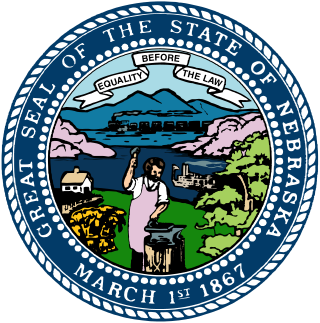
The 1880 United States presidential election in Nebraska took place on November 2, 1880, as part of the 1880 United States presidential election. Voters chose three representatives, or electors to the Electoral College, who voted for president and vice president.

The 1880 United States presidential election in Minnesota took place on November 2, 1880, as part of the 1880 United States presidential election. Voters chose five representatives, or electors to the Electoral College, who voted for president and vice president.

The 1880 United States presidential election in Iowa took place on November 2, 1880, as part of the 1880 United States presidential election. Voters chose 11 representatives, or electors to the Electoral College, who voted for president and vice president.

The 1880 United States presidential election in Colorado took place on November 2, 1880, as part of the 1880 United States presidential election. Voters chose three representatives, or electors to the Electoral College, who voted for president and vice president.

The 1880 United States presidential election in Kentucky took place on November 2, 1880. All contemporary thirty-eight states were part of the 1880 United States presidential election. Kentucky voters chose twelve electors to the Electoral College, which selected the president and vice president.
